January 1963 Popular Electronics
 Table of Contents Table of Contents
Wax nostalgic about and learn from the history of early electronics. See articles
from
Popular Electronics,
published October 1954 - April 1985. All copyrights are hereby acknowledged.
|
 RF Cafe visitor David M. wrote to ask that
I scan and post this article from the January 1963 edition of Popular Electronics
magazine.
It is written by Philip Hatfield, of the Receiving Tube Department of
General Electric, describing a very simple design that uses a "Compactron" vacuum tube, which consist of two triodes and a pentode.
The Compactron was a vacuum tube version of the multi-amplifier integrated
circuit of today, only without the peripheral passive biasing and coupling
components. Plug-in coils (inductors) for quick and easy frequency band changes
are the key feature here.
RCA 6AF11 Compactron vacuum tubes are still sometimes available for purchase
on eBay for $10-$40 bucks each. RF Cafe visitor David M. wrote to ask that
I scan and post this article from the January 1963 edition of Popular Electronics
magazine.
It is written by Philip Hatfield, of the Receiving Tube Department of
General Electric, describing a very simple design that uses a "Compactron" vacuum tube, which consist of two triodes and a pentode.
The Compactron was a vacuum tube version of the multi-amplifier integrated
circuit of today, only without the peripheral passive biasing and coupling
components. Plug-in coils (inductors) for quick and easy frequency band changes
are the key feature here.
RCA 6AF11 Compactron vacuum tubes are still sometimes available for purchase
on eBay for $10-$40 bucks each.
One Receiver, All Bands... thanks to plug-in coils
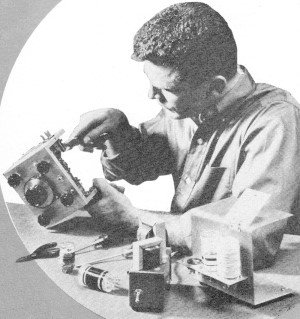 By Philip E. Hatfield, W9GFS By Philip E. Hatfield, W9GFS
Receiving Tube Dept., General Electric Co., Owensboro, Ky.
Most of today's short-wave receivers are truly sensitive and reliable devices,
but they are also rather complex and expensive for the beginner to construct. Here's
a simple receiver, using one compactron tube, that will give you long-wave, broadcast-band,
and short-wave reception. If you are considering putting your first receiver together,
this one is for you. If you, have an amateur-band-only receiver, this unit will
fill in some of the "holes" in the spectrum. Finally, if you already have a general-coverage
receiver, this set will make a good "auxiliary" to tuck a way on a corner of the
desk just in, case your "big" one quits.
Use of a compactron allows a lot of receiver to be contained in a small box without
undue crowding. the frequency range covered is from 250 kc. all the way to 16 mc.;
and, since plug-in coils are used, it's possible to extend the range in either direction.
Plenty of headphone volume is provided, and many signals will operate the built-in
speaker in a very satisfactory manner.
The Circuit

Single-tube multi-band receiver schematic.
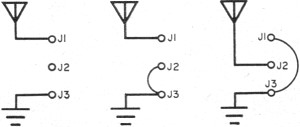
Versatility is the word on antenna hookups for
this receiver, and three possible configurations are shown.
The 6AF11 compactron contains two triodes and a pentode. One triode is used a
regenerative detector, the other as an audio voltage amplifier, and the pentode
as an audio power amplifier.
Plug-in coils containing primary (L1), secondary (L2), and tickler (L3) windings
determine the frequency range. Tuning is done with a relatively large variable capacitor
(C2) to allow covering a wide range of frequencies with a minimum of coils. For
fine tuning, a small variable capacitor (C3) is connected in parallel with the larger
one to act as a "vernier."
The antenna coupling circuit is purposely designed for versatility. Straight
inductive coupling, series tuning, or parallel tuning are possible, depending on
the connections to jacks J1, J2, and J3 (see antenna hookup diagram). This can be
quite helpful in increasing the selectivity of the receiver and in tuning out the
"dead spots" that afflict most regenerative receivers.
For maximum audio output, the headphones are operated from the pentode section
of the compactron, and the phone jack (J4) is arranged to disconnect the speaker
when the phones are in use.
The Receiver
All parts of the receiver, with the exception of
the spare-coil rack, and the trap door for coil changing, are mounted on the portion
of the chassis box used to form the front panel and sides. As the photos show, this
makes all parts of the receiver readily accessible to the builder. In addition,
since no electrical components are mounted on the removable portion of the box,
all the testing that is necessary can be done before the cabinet is "buttoned up."
To reduce sheet metal bending to a minimum, the chassis proper is a fiat plate,
cut to make a fairly snug fit, and then fastened in place with four small angle
brackets. All mounting holes should be cut in this plate and the chassis box before
the plate is bolted in place.
After the holes have been drilled, all of the parts should be mounted, since
they are all readily accessible for wiring in any sequence. In mounting the 40 p.p.f.
antenna tuning capacitor (C1), flat washers should be used between the panel and
the capacitor frame to insure that the screws don't extend through the frame far
enough to interfere with the rotor.
Wiring of the receiver isn't especially critical, and the receiver is compact
enough to allow component leads to fur-nish many of the connections. However, be
careful to wire the coil socket exactly as shown, since proper wiring here is just
as important as on the tube socket.
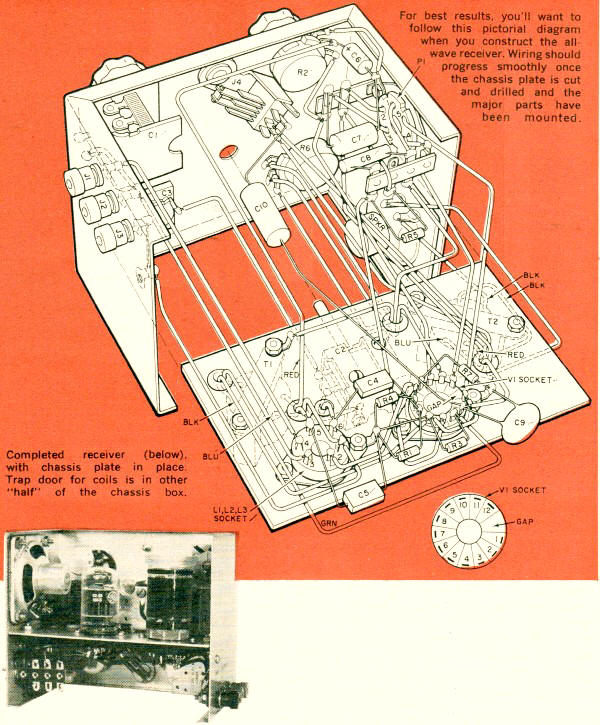
Chassis Assembly Wiring Drawing
The Power Supply. A separate entity, the power supply is built
on a 5" x 2¼" x 2¼" chassis box. Holes for the various parts should
be drilled in the box and all parts mounted before any wiring is done. Again, the
wiring isn't critical, although care should be taken in connecting leads to the
output socket (J5) to make sure that the proper socket con-tacts are used.
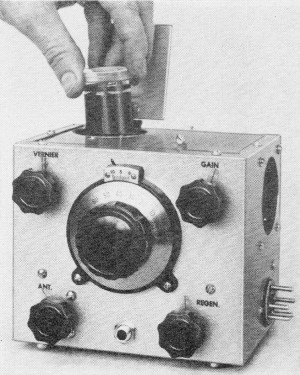 No likelihood of losing coils with this set
- one inserted through a trap door is always in use.

The other three rest in empty sockets mounted on aluminum flange at rear of cabinet.
The power cable which connects the power supply to the receiver is made from a length
of five-conductor, plastic-covered cable. This cable allows the power supply to
be placed in some con-venient spot away from the receiver. If the plastic-covered
cable isn't available, individual stranded insulated wires can be used to make the
cable, with bands of tape fastened at intervals to keep it together. Be sure that
the wires used for the heaters are at least #20 gauge. Before testing the receiver,
double-check to see that all of the plugs and sockets are correctly wired so that
the voltages January, 1963 from the power supply arrive at the right points in the
receiver.
The Coils. Before the receiver can be tested, at least one of
the plug-in coils must be wound. Start with the broadcast coil, since it covers
the range where results are easiest to obtain.
The polystyrene forms will call for some cautious handling-when drilling, too
much pressure may crack them; and, when soldering, excessive heat will soften them.
Lightly filing the ends of the coil form pins to remove the plating will make soldering
easier. Remember, rapid soldering is required to prevent soften-ing of the form.
Start by winding the primary, followed by the secondary, and then the tickler.
One way to make a neat job is to push the wire through the starting hole in the
form and into the pin and then solder it in place. Then unwind the amount of wire
from the spool that you think will be required, but don't cut the wire just yet.
Instead, clamp the spool in a vise and walk away until the wire is under slight
tension.
Wind the coil by turning the coil form in your hands as you walk slowly toward
the vise. If you have underestimated the wire needed, or if your workshop is small,
hold the coil in one hand to prevent the wire from slipping, remove the spool from
the vise, unwind more wire, re-clamp the spool, and continue winding. If you take
your time, you should have a professional-looking winding job with the wire tightly
wound and uniformly spaced.
When the proper number of turns has been wound on, cut off the wire (leaving
a lead of about 6/1) , put the wire through the proper hole in the form, place your
thumb over the hole to hold the wire in place, remove the insulation from the wire,
push the wire through the proper base pin, and solder it in place.
Incidentally, it's especially important that the secondary and tickler coils
(L2 and L3, respectively) be wound in the same direction. If they're not, the re-generative
detector won't operate properly. In the event that you experience trouble in getting
the set to oscillate, try reversing connections to either L2 or L3 - not both!
Although information on the other coils is given below, it will probably be better
for you to skip over to the "Operation" section at right, read that material, and
try the receiver. Then you can come back and wind the other coils. Three of the
coils are single-layer af-fairs, and are all wound in the same manner (one being
the broadcast-band coil described above). However, it's im-possible to place enough
wire in a single layer on the 250 - 600 kc. coil, so a different winding style is
used for this one. To wind the 250 - 600 kc. coil, drill all of the holes in the
form, but wind the secondary coil (L2) first. Solder one end of the wire in place
and make several large looping turns up to the hole at which the secondary coil
will end. Now start back down the coil and wind in the same manner, reaching the
hole in the form where the coil started in only a few turns. Continue winding up
and down the form until the specified number of turns are in place. The purpose
of this winding method is to make as many of the turns as possible cross at angles
rather than lie parallel and thus reduce the distributed capacitance.
After the secondary has been completed, wind the primary (L1) and tickler (L3)
coils at the proper ends of the form. These coils should be scrambled-wound, with
the turns touching the ends of the secondary. Strips of plastic cement or coil dope
can be run vertically at ½" intervals around the forms to hold the wires
in place.
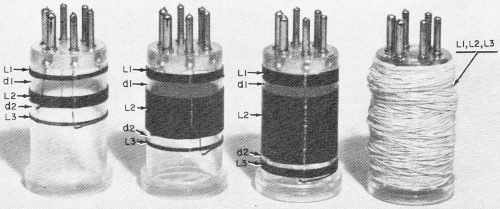
Various Wound Coils
Operation. Check the wiring, connect the power supply to the
receiver with the power supply cable, and plug in the broadcast coil. Connect an
antenna to the ANT 1 binding post (J1), and a ground to the GND binding post (J3).
Set the REGEN control (R2) in the extreme counterclockwise position, the ANT (C1)
and GAIN (R6) controls in the extreme clockwise position, and the VERNIER control
(C3) in the center of its range.
Turn on the power supply. After warm-up, turn the REGEN control clockwise until
a hissing sound is heard in the speaker. Now back off the control until the hiss
just stops; this is the most sensitive point for reception of AM stations.
If you have trouble separating strong local stations, turn the ANT control counterclockwise.
This increases the selectivity by decreasing the coupling of the antenna to the
receiver. With extremely strong local stations, it may be necessary to use a very
short antenna to limit the signal strength.
When you use the short-wave coils, you'll find that adjusting the tuning and
regeneration controls is more critical. Tuning is best done by adjusting the main
dial to the vicinity of the station you wish to hear and then doing the fine tuning
with the VERNIER capacitor. Set the regeneration control to the point where the
hiss starts to receive c.w. signals; and just below this point to receive phone
signals. If the receiver refuses to oscillate at certain dial settings, change the
antenna coupling by means of the ANT capacitor, or try the alternative antenna connections
shown in the diagram on page 40.
With the long-wave coil in place, the receiver should handle about as it does
on the broadcast band. And don't forget that additional coils to extend the range
in both directions can be wound in a cut-and-try fashion.

One Receiver - All Wave Parts List
Posted October 19, 2022
(updated from original post
on 8/22/2012)
|









 By Philip E. Hatfield, W9GFS
By Philip E. Hatfield, W9GFS






